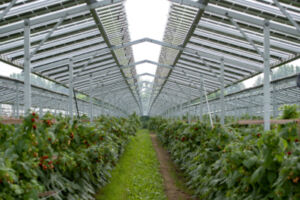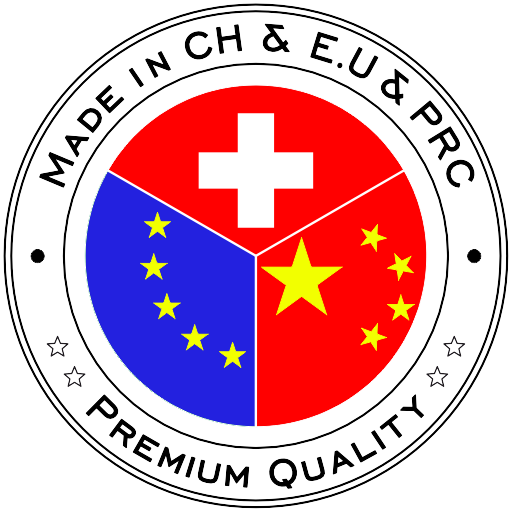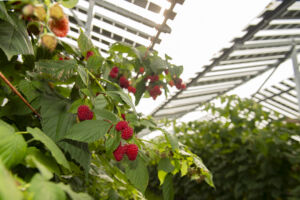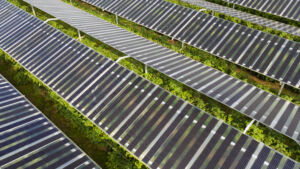
AGRI-PHOTOVOLTAICS
AGRI-PV PLANTS

These conditions take into account, for example, solar radiation, weather, possible litter damage, water drainage or recirculation, cultivation, logistics and fertilisation, pest control and plant protection as well as crop planning and management. The aforementioned agronomic advantages of our Agri-PV systems lie particularly in the creation of ideal growing conditions in vegetables, berry and fruit crops. In the main purpose, our Agri-PV systems primarily take on the function of a stable weather protection against sunburns, frost, heavy rain, hail and gusts of wind, and secondarily, that of long-term energy production through photovoltaics. Both functions offer, in addition to great economic advantages due to the maximum efficiency of land use, also a better microclimate under the Agri-PV systems, which in turn enable a resource-saving vegetables, berry and fruit cultivation (less water requirement, more precise fertilisation, less heat stress and thus more resistant plants and higher quality harvests…). The construction of an Agri-PV plant is subject to planning permission and is possible in principle from 2022. The spatial planning and other legal provisions (e.g. crop rotation areas, spatial development, inner extension / intensive agricultural zone, site constraints, Ordinance on Direct Payments or the Federal Law on Rural Land Rights) already enable our authorities to approve the construction of our Agri-PV plants outside of building zones in accordance with zoning regulations. As part of the project process planning, official hurdles are specifically addressed and constructively implemented. Precision farming is also becoming more important among our Agri-PV systems: automatic steering assistance systems, autopilots, drones or automated tractor concepts (ATC) are made for our Agri-PV systems. GPS position signals as well as real-time kinematic corrections are replaced in our systems by sensor data that are oriented to the system design and no longer to rovers, satellites and base stations. This allows farmers to use tractors and machines that can drive much more precisely and autonomously (less work) and to have an ATC that would be available at a lower cost than usual systems on the market. However, precision farming methods are also increasingly aimed at the resource-saving production of crops, e.g. by saving pesticides and water, which is desired and also achieved in our agrivoltaic systems.
ADVANTAGES OF AN AGRI-PV PLANT

- Long-term stable weather protection in vegetables, berry and fruit cultures against sunburns, frost, heavy rain, hail and gusts of wind
- Increase farm income Thanks to very high energy production on the farm’s usable area (max. land use efficiency).
- Better microclimate thanks to protected cultivation under Agri-PV plants as well as resource-saving berry and fruit cultivation (less use of water and pesticides)
- Receive specific subsidies for renewable energies and lighthouse plants (conditional research contribution, specifically for agri-photovoltaic plants, available from 2023)
- Term cultivation can be planned due to uniform growth and ripeness of the fruits as well as relief of the “peaks” in the cultivation. Optimal temperatures during heat waves in summer are achieved without additional shading efforts
- Better climate conditions for farm staff and harvest workers as well as integral possibility to use automated tractor concepts (ATC) here (less work)
- Ecological and economical alternative to plastic covers (marketing advantages through differentiation from the competition)
- Foundationless system with short dismantling time (flexible in the use of the land)
A simple, economical and clean solution for covering valuable berry and fruit crops. Without concrete foundations, cleanable from above and below and ready for immediate use!
The static construction is absolutely weatherproof and stable for generations. In addition, our Agri-PV systems are characterised by very low operating costs.
There are many reasons to believe that such Agrivoltaic systems – i.e. weatherproof and stable weather protection constructions – will continue to prove to be a good-paying and long-term one-time investment for many farmers.

WHY JBMC INC
Sustainable development from which everyone Involved can benefit and grow – in the form of an economic, ecological and social return. This is what we stand for!
For people, your livestock and our environment

developed in CH, E.U & the PRC
SYSTEMS / MODE OF OPERATION
It is widely known that light energy can only be used once. So there is no magic here for our plant systems either! The question that intelligently arises here is whether it would not make sense to make use of the surplus light irradiation in vegetables berry and fruit cultures and convert it into farm income by means of Agri-PV.
The unique synergy formed here between food production and energy generation is absolutely groundbreaking for a successful realisation of our energy transition. Our Agri-PV plants – individually adapted to the cultivation requirements – are technical constructions which take over a long-term weather protection function and convert surplus solar radiation into electricity. Agri-PV energy generation systems consist of three main parts (the solar power plant, the stationary large-scale storage facility with the associated power conversion and management systems, and a transformer station for connection to the power grid). The solar park is the most extensive part of an Agri-PV construction project. Here, highly efficient HT double-glass modules are mounted on a solid, drive-under substructure. The modules are all bifacial, enabling maximum use of sunlight from all sides. The efficiency of our panels is the highest possible in industrial production! The substructure is made of anti-corrosion coated steel and stands for quick installation, long-term use, and profitability. The direct current (DC) generated during the day is fed into a storage facility, where it is stored for the following night's grid supply (or for a maximum of a few days). Our storage units are deep-discharge-proof and have a high cycle stability. The stored electricity is then converted into alternating current (AC) via a CPCS (central power conversion system) and fed into the distribution network via an EMS (energy management system) with a grid-connected function and a transformer. These systems are economical, absolutely weatherproof and stable over generations. In addition, our Agri-PV systems are characterised by very low operating costs, which increases their profitability and thus reduces their depreciation period. After dozens of years of use, the solar panels can be easily replaced from below without the use of a crane. In the event of the sale of the plot, the plant could be dismantled within a short time and the high-quality materials – if the plant were not to be reused – could be recycled at a rate of >95% and sold. Our Agrivoltaik systems can be individually adapted to the cultivation requirements, especially in the optimal coordination of the so important light transmission in relation to the cultivation and production methods selected by the farm. Yield reductions are to be expected with Agri-PV systems, but they remain manageable at all times, are very stable from year to year and are offset many times over by the additional income from electricity generation. EXCHANGE OF EXPERIENCE CH & EU
AGRONOMY

At our latitude, plug-in plants as well as cuttings (young plants after their propagation) need the highest possible light irradiation to form lateral buds at the desired time and to bear fruit later, on schedule. Flowering (transition from the vegetative to the reproductive phase) either occurs autonomously when the plant reaches a certain stage of development (flowering maturity) or can also be induced by the length of daylight (photoperiodism), in many plants also in response to stress factors (drought, pest infestation). The latter method is widely used today in the propagation of, for example, various long canes (autumn and summer raspberry varieties) and is primarily used to produce healthy and vigorous plants. In production, vegetables and the above-mentioned berries need and tolerate a certain amount of shade. This shading is optimally and homogeneously produced under an optimally designed agri-photovoltaic plant and can thus guarantee the desired yields even under exceptionally unfavourable weather conditions. However, robust varieties are still recommended under Agri-PV plants! The flowering and light transmission of the panels are therefore important cultivation factors that must be taken into account in individual cases and, when planning construction projects, optimally coordinated with each other. In addition to the vegetables and the above-mentioned berry cultivation, agrivoltaic systems are also conceivable via pome fruit and espalier fruit systems. As these in turn belong to the category of permanent crops and have partly proved to be delicate crops – point light management – we would like to see long-term research results on existing plants before agrivoltaic is built over such cultivation areas. The height of the plant under pome fruit could also be a limiting factor, because height means costs, and these – in addition to an often lower density of solar cells above pome fruit plants – are decisive for the profitability of an agri-PV project. It is quite conceivable that the advantages of Agri-PV systems above pome fruit and espalier fruit plants could lie in the reduction of frost irrigation and chemical thinning (fruit hanging).



